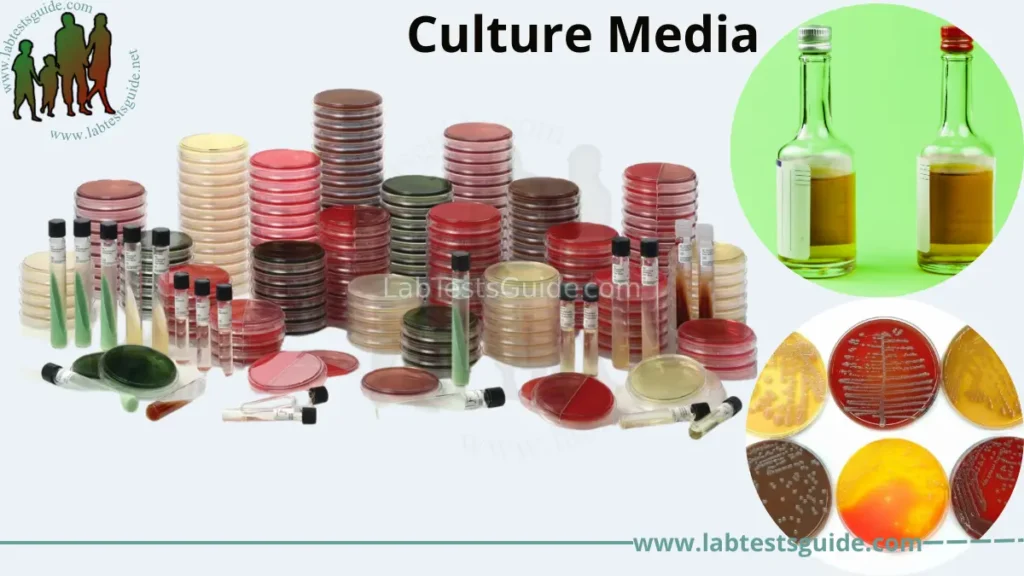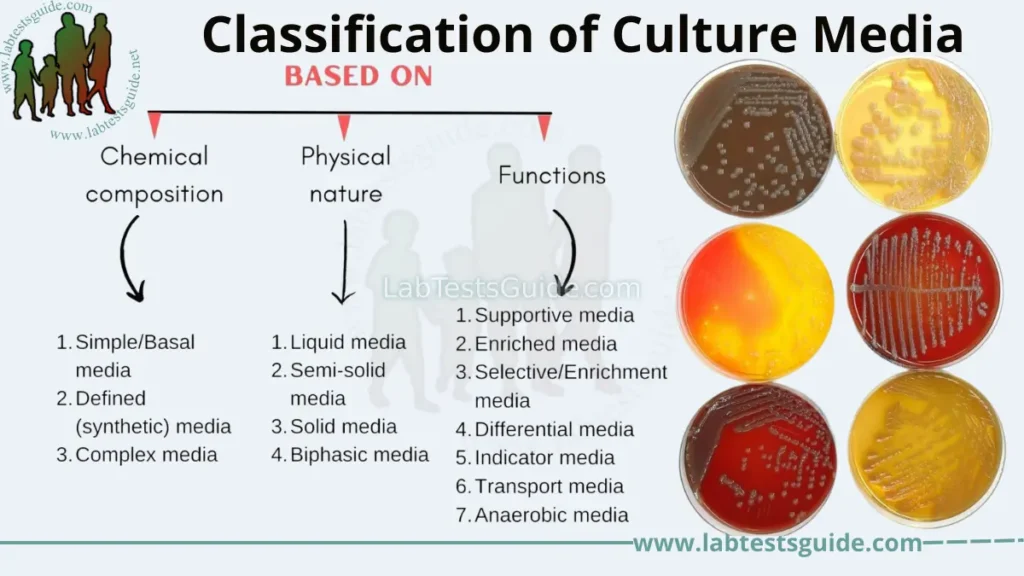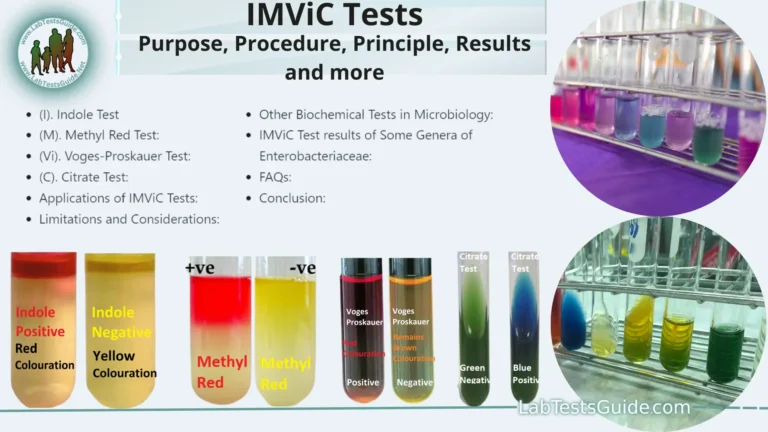Culture media refers to the nutrient-rich substances used in laboratories to support the growth and multiplication of microorganisms, such as bacteria, fungi, and viruses. These media contain essential nutrients such as amino acids, vitamins, carbohydrates, and minerals, which provide a favorable environment for the microorganisms to thrive. Read Old Article

Defination of Culture Media:
Culture media refers to the nutrient-rich substances used in laboratories to support the growth and multiplication of microorganisms, such as bacteria, fungi, and viruses. These media contain essential nutrients such as amino acids, vitamins, carbohydrates, and minerals, which provide a favorable environment for the microorganisms to thrive.
Slassification of Culture Media:
Culture media can be classified based on several criteria, including their physical state, composition, and purpose. Here are some common classification methods:
- Physical state: Culture media can be classified as solid, semisolid, or liquid.
- Composition: Culture media can be classified based on their nutrient content, including general-purpose media, enriched media, selective media, differential media, and enrichment media.
- Purpose: Culture media can be classified based on their intended use, including diagnostic media, research media, production media, and quality control media.
- Mode of use: Culture media can be classified based on their mode of use, including batch media, fed-batch media, and continuous media.
- Chemical structure: Culture media can be classified based on their chemical structure, including complex media, defined media, and synthetic media.

Based on Chemical Composition:
Culture media can be classified based on their chemical composition as:
- Synthetic media: These are chemically defined media that contain known amounts and types of pure organic and inorganic compounds. These media are used to cultivate fastidious microorganisms that require specific nutrients for growth.
- Complex media: These are nutrient-rich media that contain a complex mixture of organic and inorganic compounds, such as peptones, meat or plant extracts, and sugars. Complex media are used to cultivate a wide range of microorganisms and are often supplemented with selective agents or indicators.
- Semi-synthetic media: These are a combination of synthetic and complex media that are often used to study the nutritional requirements of microorganisms.
- Selective media: These are designed to select for specific microorganisms by inhibiting the growth of unwanted organisms and promoting the growth of the desired ones. These media contain specific inhibitors or selective agents that target certain metabolic pathways or enzymes.
- Differential media: These are used to differentiate between different types of microorganisms based on their metabolic characteristics or biochemical reactions. Differential media contain specific indicators that change color or produce a visible reaction when a certain metabolic pathway is activated or inhibited.
Based on Physical Nature:
Culture media can also be classified based on their physical nature as:
- Liquid media: These are culture media that exist in a liquid state. They can be transparent or opaque depending on their composition. Liquid media are useful when a large number of microorganisms are required, and they allow for easy mixing and distribution of nutrients.
- Semisolid media: These are culture media that have a thicker consistency than liquid media, but not as thick as solid media. They are useful for detecting motility or changes in pH. Semisolid media are also used for the cultivation of anaerobic microorganisms.
- Solid media: These are culture media that have a firm, solid consistency. They are used for the isolation and cultivation of microorganisms, and for the determination of colony morphology. Solid media can be further classified as:
- Agar: This is the most commonly used solidifying agent in culture media. Agar is derived from seaweed and is used because it is not degraded by most microorganisms and is solid at temperatures above 45°C but liquid at temperatures below 45°C.
- Gelatin: This was one of the first solidifying agents used in culture media. However, it is not as commonly used now because it is degraded by many microorganisms and is not suitable for use at high temperatures.
- Agarose: This is a purified form of agar and is used in the preparation of DNA and protein gels for electrophoresis.
- Gaseous media: These are media that are used for the growth of microorganisms in an atmosphere that is different from air, such as carbon dioxide or nitrogen. They are often used in specialized incubators.
Based on Functions:
Culture media can also be classified based on their functions, which include:
- Enrichment media: These are media that are designed to promote the growth of a particular organism in a mixed culture. They contain nutrients that selectively support the growth of the desired organism while suppressing the growth of other organisms.
- Selective media: These are media that contain substances that inhibit the growth of unwanted organisms, while allowing the growth of the desired organism.
- Differential media: These are media that contain indicators that allow for the differentiation of different types of microorganisms based on their biochemical properties.
- Indicator media: These are media that contain indicators that change color in the presence of certain microorganisms or metabolic products, indicating the presence of a particular organism or activity.
- Transport media: These are media that are designed to maintain the viability of microorganisms during transportation to a laboratory for further analysis.
- Assay media: These are media that are designed to measure the activity or concentration of a particular substance, such as enzymes or antibiotics, produced by microorganisms.
- Basal Media: Basal media are used to support the growth of microorganisms that require minimal nutrient supplementation from the medium. Examples of basal media include nutrient agar, tryptic soy agar, and brain heart infusion agar.
Types of Culture Media:
There are several types of culture media used in microbiology, including:
- Solid or Agar media: Solid media containing agar, which provides a gel-like structure that supports the growth of microorganisms.
- Liquid media: Nutrient-rich liquids that are used to grow microorganisms in suspension.
- Selective media: Contain substances that selectively allow the growth of specific types of microorganisms while inhibiting the growth of others.
- Differential media: Contain substances that allow the differentiation of microorganisms based on their biochemical and metabolic characteristics.
- Enrichment media: Used to grow fastidious microorganisms that require specific growth factors.
- Transport media: Used to transport microorganisms to a laboratory for further analysis.
Components of Culture Media:
Culture media typically contain several components that provide the essential nutrients and support necessary for the growth and multiplication of microorganisms. Here are some of the main components of culture media:
- Carbon sources: provide the energy needed for microbial metabolism, such as glucose or sucrose.
- Nitrogen sources: provide the building blocks for microbial proteins, such as amino acids, peptones, and nitrates.
- Vitamins: required for many microbial metabolic processes, such as thiamine, riboflavin, and niacin.
- Minerals: essential for microbial growth and enzymatic function, such as iron, magnesium, and calcium.
- Growth factors: specific nutrients required by certain microorganisms that cannot be synthesized by themselves, such as hemin, NAD, or specific amino acids.
- pH buffers: maintain the optimal pH range for microbial growth, such as phosphate or carbonate buffers.
- Water: the solvent for all the components and necessary for cell metabolism and replication.
The exact composition of culture media may vary depending on the intended use and the microorganisms being cultured. For example, some microorganisms may require specialized nutrients or growth factors that are not needed by others.
Consistency of Culture Media:
The consistency of culture media can vary depending on the type and purpose of the media. Here are some of the common consistencies of culture media:
- Liquid Media: culture media that are liquid in consistency, such as broth media. These media are useful for culturing microorganisms in suspension.
- Semisolid Media: culture media that have a jelly-like consistency, such as soft agar media. These media can be used to detect motility or to localize bacterial growth.
- Solid Media: culture media that are firm and can hold their shape, such as agar media. These media are useful for isolating and identifying microorganisms based on their colony morphology and biochemical characteristics.
- Gel-like Media: culture media that are similar in consistency to gelatin, such as carrageenan. These media are often used for industrial-scale fermentation processes.
- Powdered Media: culture media that are dry and powdered, requiring the addition of water or other solvents before use. These media are often used for long-term storage or for making custom formulations.
The consistency of culture media can have a significant impact on the growth and behavior of microorganisms, so it is important to choose the appropriate consistency for the intended purpose.
Preparation of Culture Media:
The preparation of culture media can vary depending on the type of media and the intended use. However, here are the general steps involved in preparing culture media:
- Weigh out the required amounts of each component based on the desired final volume and composition of the media.
- Dissolve the components in water or a solvent according to the manufacturer’s instructions or a predetermined recipe.
- Adjust the pH of the media to the appropriate range using a pH meter or pH indicator strips.
- Sterilize the media by autoclaving, filtration, or another appropriate method to ensure that it is free of microorganisms.
- Pour the media into sterile containers, such as petri dishes, tubes, or bottles.
- Allow the media to solidify or cool to the appropriate temperature before use.
It is essential to work in a sterile environment and to use sterile equipment throughout the preparation process to prevent contamination of the media. Additionally, it is important to ensure that the composition and quality of the media are consistent from batch to batch to ensure reliable results. Quality control measures such as testing for sterility and pH should be performed regularly.
Common Medias used in Rutine Microbiology:
There are many different types of culture media used in routine microbiology, but here are eight common media that are frequently used:
- Blood agar: a general-purpose medium used for the isolation of a wide variety of microorganisms, especially fastidious organisms. Blood agar contains sheep blood, which provides nutrients and allows for the detection of hemolytic activity.
- MacConkey agar: a selective and differential medium used for the isolation and identification of gram-negative bacteria, especially Enterobacteriaceae. MacConkey agar contains bile salts and crystal violet, which inhibit the growth of gram-positive bacteria, and lactose, which is fermented by lactose-fermenting bacteria and produces pink colonies.
- Sabouraud agar: a selective medium used for the isolation of fungi and yeasts. Sabouraud agar contains peptones, dextrose, and agar, and has a low pH, which inhibits the growth of most bacteria.
- CLED agar: a differential medium used for the isolation and identification of urinary tract pathogens. CLED agar contains lactose, which is fermented by lactose-fermenting bacteria and produces yellow colonies, and inhibitors that prevent the growth of gram-positive bacteria.
- Chocolate agar: a general-purpose medium used for the isolation of fastidious microorganisms, especially Haemophilus and Neisseria species. Chocolate agar is made by heating blood agar to release hemin and NAD, which are required by these microorganisms.
- Nutrient agar: a general-purpose medium used for the cultivation of a wide range of microorganisms. Nutrient agar contains peptones, beef extract, yeast extract, and agar, and provides the basic nutrients required for bacterial growth.
- Mueller Hinton Agar: a general-purpose agar medium that is used for the antibiotic susceptibility testing of bacteria. It contains beef extract, casein hydrolysate, and starch, and is used for the diffusion of antimicrobial agents.
- Mannitol Salt Agar: a selective and differential agar medium used for the isolation and identification of Staphylococcus aureus. It contains high concentrations of salt to inhibit the growth of most other bacteria, and mannitol and phenol red to differentiate between mannitol-fermenting and non-fermenting bacteria.
List of Agars, Broths and Media:
| Type of Media | Name of Media | Purpose |
|---|---|---|
| Media | Alkaline Peptone Water | enrichment of Vibrio cholerae, the bacterium that causes cholera |
| Media | Amies Transport Medium | transportation of clinical specimens, such as throat, wound, and skin swabs |
| Agar | Anaerobic Blood Agar | culture anaerobic bacteria that require blood for growth |
| Agar | Ashdown’s Agar | isolation and identification of Campylobacter jejuni and Campylobacter coli |
| Agar | Bacillus cereus agar | isolation and identification of Bacillus cereus, a common foodborne pathogen |
| Agar | Baird Parker Agar | Isolation and identification of Staphylococcus aureus |
| Agar | BCYE Agar | cultivation and isolation of Legionella species |
| Agar | Bile Esculin Agar | Isolation and identification of enterococci |
| Agar | Bird Seed Agar | isolation of Cryptococcus neoformans |
| Agar | Bismuth sulfite agar | Isolation and identification of Salmonella spp. |
| Agar | Bismuth Sulphite Agar (BSA) | isolation and identification of Salmonella typhi and other Salmonella species |
| Agar | Blood agar | Cultivation of a wide range of microorganisms, including fastidious bacteria and fungi |
| Agar | Brain Heart Infusion (BHI) Agar | Cultivation of fastidious microorganisms, including fungi |
| Broth | Brain Heart Infusion Broth (BHI) | General-purpose broth medium for the cultivation of a wide range of microorganisms |
| Agar | Brilliant Green Agar | Selective medium for the isolation of Salmonella spp. |
| Agar | Brucella Agar | General-purpose medium for the cultivation of bacteria |
| Agar | Buffered Charcoal Yeast Extract Agar | Isolation and identification of Legionella spp. |
| Agar | Campylobacter Blood Agar (CVA) | Selective medium for the isolation of Campylobacter spp. |
| Media | Cary Blair Transport Medium | preservation and transport of fecal specimens for the detection of enteric pathogens |
| Agar | Cetrimide Agar | Isolation and identification of Pseudomonas aeruginosa |
| Agar | Charcoal Selective Medium | isolation and cultivation of Legionella pneumophila |
| Agar | Chocolate agar | Cultivation of fastidious bacteria, especially Haemophilus spp. and Neisseria spp. |
| Agar | CHROM agar | isolation, differentiation, and identification of various microorganisms, particularly bacteria |
| Agar | CLED Agar | Isolation and identification of urinary tract pathogens |
| Agar | Clostridium agar | isolation and differentiation of Clostridium species |
| Agar | Columbia Agar | isolation and cultivation of a wide variety of microorganisms |
| Agar | Cystine Glucose Blood Agar | isolation and differentiation of Clostridium spp |
| Agar | Cystine Tryptic Agar | identification of microorganisms based on their ability to ferment different sugars |
| Agar | Czapek’s Agar (CZA) | cultivation and differentiation of filamentous fungi, especially those belonging to the Aspergillus and Penicillium genera |
| Agar | Deoxycholate Citrate Agar (DCA) | Isolation and identification of gram-negative enteric bacteria |
| Agar | Egg Yolk Agar | Detection of lecithinase and lipase activity |
| Agar | Endo Agar | isolation and differentiation of gram-negative bacteria, particularly members of the Enterobacteriaceae family |
| Agar | Eosin Methylene Blue (EMB) agar | Isolation and differentiation of lactose-fermenting and non-fermenting gram-negative enteric bacteria |
| Broth | Fluid Thioglycollate Medium | Anaerobic cultivation of microorganisms |
| Agar | Heart Infusion Agar | cultivation of a wide variety of microorganisms, including bacteria, fungi, and yeasts |
| Agar | Hektoen enteric agar | Isolation and identification of gram-negative enteric bacteria |
| Broth | Lactobacilli MRS Broth | cultivation and enumeration of lactobacilli |
| Broth | Lactose Broth | Detection of lactose-fermenting bacteria |
| Agar | Legionella agar | isolation and cultivation of Legionella species, particularly Legionella pneumophila |
| Agar | Levinthal’s Medium | cultivation and identification of pathogenic strains of Listeria monocytogenes |
| Agar | Listeria monocytogenes agar | isolation and identification of Listeria monocytogenes |
| Media | Loeffler Medium | cultivation and identification of Corynebacterium diphtheriae |
| Agar | Lowenstein Jensen (LJ) Media | Cultivation of Mycobacterium tuberculosis |
| Agar | Lysine Iron Agar (LIA) | identification of enteric bacteria based on their ability to decarboxylate lysine and produce hydrogen sulfide |
| Agar | MacConkey agar | Isolation and identification of gram-negative enteric bacteria |
| Broth | MacConkey Broth | Detection of lactose-fermenting bacteria |
| Agar | Mannitol Salt Agar | Isolation and identification of Staphylococcus aureus |
| Agar | Martin Lewis Agar | isolation and identification of pathogenic species of Legionella |
| Agar | Middlebrook Agar | isolation and cultivation of mycobacteria, particularly Mycobacterium tuberculosis |
| Agar | Modified Thayer Martin Agar | isolation and identification of pathogenic Neisseria species, particularly Neisseria gonorrhoeae |
| Agar | Mueller Hinton Agar (MHA) | Antibiotic susceptibility testing of bacteria |
| Agar | New York City Agar | isolation and identification of fungi, particularly dermatophytes, from clinical specimens such as skin, hair |
| Agar | Nutrient agar | General-purpose agar medium for the cultivation of a wide range of microorganisms |
| Broth | Nutrient Broth | General-purpose broth medium for the cultivation of a wide range of microorganisms |
| Media | Peptone Water | cultivation of a wide range of microorganisms, including bacteria, yeast, and fungi. |
| Broth | Peptone Yeast Extract Glucose Broth | cultivation of a wide range of microorganisms, including bacteria, yeast, and fungi. |
| Agar | Plate Count Agar (PCA) | enumeration of viable microorganisms in a variety of specimens, including food, water, and environmental samples |
| Agar | Potato Dextrose Agar (PDA) | Cultivation of fungi |
| Agar | Reinforced Clostridial Agar | Cultivation of anaerobic bacteria |
| Agar | Sabouraud Dextrose Agar (SDA) | Cultivation of fungi and yeast |
| Agar | Salmonella-Shigella agar | isolation and identification of enteric pathogens such as Salmonella and Shigella |
| Broth | Selenite F Broth | Enrichment and isolation of Salmonella spp. |
| Agar | Simmons Citrate Agar | Differentiation of microorganisms based on their ability to use citrate as a carbon source |
| Broth | Simmons Citrate Broth | Differentiation of microorganisms based on their ability to use citrate as a carbon source |
| Agar | Sorbitol MacConkey Agar | detection and isolation of enterohemorrhagic Escherichia coli (EHEC), particularly serotype O157:H7 |
| Agar | Starch Casein Agar (SCA) | cultivation and enumeration of a wide range of microorganisms, including bacteria and fungi. |
| Agar | Streptococcus Selective Agar | isolation and identification of Streptococcus species |
| Agar | TCBS Agar | Isolation and identification of Vibrio spp. |
| Agar | Thayer-Martin Agar | Selective cultivation of Neisseria gonorrhoeae |
| Broth | Thioglycollate Broth | Anaerobic cultivation of microorganisms |
| Agar | Triple Sugar Iron (TSI) Agar | Differentiation of microorganisms based on their ability to ferment different sugars and produce hydrogen sulfide |
| Agar | Tryptic Soy Agar (TSA) | General-purpose agar medium for the cultivation of a wide range of microorganisms |
| Broth | Tryptone Soya Broth (TSB) | General-purpose broth medium for the cultivation of a wide range of microorganisms |
| Agar | Urea Agar | Detection of microorganisms that can hydrolyze urea |
| Agar | Vancomycin-resistant enterococci agar | isolation and identification of vancomycin-resistant enterococci |
| Agar | Violet Red Bile Agar (VRBA) | Detection and enumeration of coliform bacteria in food and water |
| Media | Viral Transport Media (VTM) | used for the collection, transport, and preservation of clinical specimens containing viruses or chlamydiae for diagnostic testing. |
| Agar | Xylose Lysine Deoxycholate agar | Isolation and identification of gram-negative enteric bacteria |
| Agar | Yeast Extract Peptone Dextrose (YPD or YEPD) Growth Agar | used for the growth and maintenance of a wide range of microorganisms, including bacteria, yeast, and fungi. |
| Agar | Yersinia Selective Agar | Isolation and identification of Yersinia enterocolitica |
Quality Control of Culture Media:
Quality control of culture media is a crucial step in microbiological testing to ensure that the culture media used are suitable for the intended purpose and that the results obtained from them are accurate and reliable. Here are some common quality control measures used for culture media:
- Sterility testing: Culture media must be sterile to avoid contamination of samples. Sterility testing is done by inoculating a sample of the culture medium and incubating it under appropriate conditions to check for microbial growth.
- pH testing: The pH of the culture medium must be within the acceptable range for the intended microorganism. The pH can be measured using a pH meter or indicator paper.
- Performance testing: This involves testing the ability of the culture medium to support the growth of the target microorganisms. This is done by inoculating the medium with a known strain of the target microorganism and observing for growth.
- Specificity testing: This is done to ensure that the culture medium only supports the growth of the target microorganism and not other non-target microorganisms. It involves inoculating the medium with other non-target microorganisms and observing for growth.
- Selectivity testing: This is done to ensure that the culture medium inhibits the growth of unwanted microorganisms while allowing the growth of the target microorganism. It involves inoculating the medium with a known strain of the target microorganism and other non-target microorganisms to observe the level of growth.
- Limit testing: This is done to ensure that the culture medium is free from toxic substances that could affect the growth of microorganisms. It involves inoculating the medium with a known strain of microorganism and observing for growth in the presence of increasing concentrations of the test substance.
- Storage testing: This is done to ensure that the culture medium remains stable during storage. The stability of the medium is tested by incubating a sample of the medium stored under recommended conditions and observing for microbial growth.
FAQs:
Q: What is culture media?
A: Culture media is a nutrient-rich substance used for the growth, isolation, and identification of microorganisms.
Q: What are the types of culture media?
A: Culture media can be classified as solid, liquid, or semisolid. It can also be classified as chemically defined or undefined, selective, differential, or enrichment media, depending on its composition and intended purpose.
Q: Why is culture media sterilized?
A: Culture media is sterilized to prevent contamination by unwanted microorganisms that could interfere with the growth and identification of the desired microorganisms.
Q: What is the difference between selective and differential media?
A: Selective media is designed to promote the growth of certain types of microorganisms while inhibiting the growth of others. Differential media is designed to allow the identification of microorganisms based on their physical or biochemical characteristics.
Q: What is enrichment media?
A: Enrichment media is used to increase the number of desired microorganisms in a sample by providing specific nutrients that favor their growth, making it easier to detect and identify them.
Q: What is the purpose of quality control of culture media?
A: Quality control of culture media ensures that the media is suitable for its intended purpose and that the results obtained are accurate and reliable. It involves testing the media for its physical and chemical properties, sterility, and ability to support the growth of specific microorganisms.
Conclusion:
In conclusion, culture media are essential components in microbiology laboratory procedures for the growth and identification of microorganisms. The type of culture media used depends on the type of microorganisms being cultured and the purpose of the culture. The preparation, consistency, and quality control of culture media are crucial in ensuring reliable and accurate results in microbiological analyses. Quality control of culture media involves testing for the ability of the media to support growth of microorganisms, sterility, and pH among other parameters. Proper quality control of culture media helps to identify any contamination or other issues that may affect the validity of microbiological analyses.
References:
- Atlas, R.M. (2010). Handbook of Microbiological Media. CRC Press.
- Forbes, B. A., Sahm, D. F., & Weissfeld, A. S. (2007). Bailey & Scott’s Diagnostic Microbiology. Mosby Elsevier.
- Jorgensen, J. H., & Turnidge, J. D. (Eds.). (2015). Susceptibility testing: a guide for the microbiology laboratory. John Wiley & Sons.
- Tortora, G. J., Funke, B. R., & Case, C. L. (2010). Microbiology: an introduction. Benjamin Cummings.
- Oxoid. (2021). Microbiology Culture Media. https://www.thermofisher.com/order/catalog/productCategory.jsp?brandId=19460&categoryId=81872&categoryIdName=Culture+Media&lang=en
- Hardy Diagnostics. (2021). Culture Media & Supplements. https://catalog.hardydiagnostics.com/cp_prod/Content/hugo/CultureMediaSupplements.htm
Possible References Used







